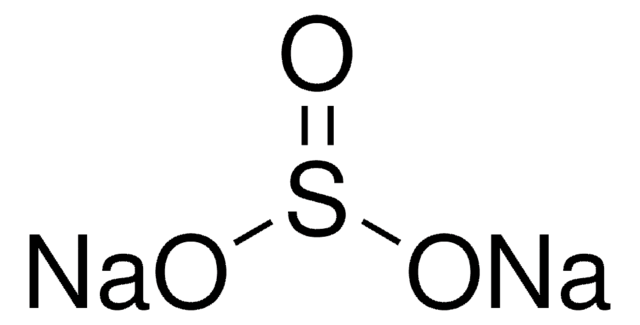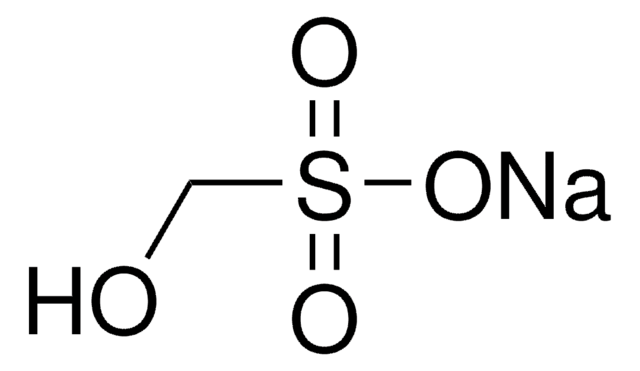S4672
Sulfite de sodium
BioXtra, ≥98%
Synonyme(s) :
Natrium sulfite, Sodium sulphite
About This Item
Produits recommandés
Gamme de produits
BioXtra
Niveau de qualité
Pureté
≥98%
Forme
powder or crystals
Impuretés
≤0.005% Insoluble matter
≤5 ppm Phosphorus (P)
Solubilité
H2O: 1 M at 20 °C, clear, colorless
Traces d'anions
chloride (Cl-): ≤0.02%
Traces de cations
Al: ≤5 ppm
Ca: ≤0.01%
Cu: ≤5 ppm
Fe: ≤5 ppm
K: ≤0.05%
Mg: ≤0.005%
NH4+: ≤0.05%
Pb: ≤10 ppm
Zn: ≤5 ppm
Chaîne SMILES
[Na+].[Na+].[O-]S([O-])=O
InChI
1S/2Na.H2O3S/c;;1-4(2)3/h;;(H2,1,2,3)/q2*+1;/p-2
Clé InChI
GEHJYWRUCIMESM-UHFFFAOYSA-L
Vous recherchez des produits similaires ? Visite Guide de comparaison des produits
Application
- A Soy Protein-Based Film Based on Chemical Treatment and Microcrystalline Cellulose Reinforcement Obtained from Corn Husk Byproducts.: This research explores the development of a soy protein-based film reinforced with microcrystalline cellulose derived from corn husk byproducts, treated chemically with sodium sulfite. The resulting film exhibited enhanced mechanical properties, making it a viable option for biodegradable packaging (Zhang et al., 2024) (Zhang et al., 2024).
- Modelling Energy-Harvesting Processes in Primitive Cells: Proton Transport Across Bilayers Driven by the Oxidation of Sulfite.: This article models the energy-harvesting processes in primitive cells, focusing on proton transport across bilayers driven by sulfite oxidation. The findings contribute to the understanding of early cellular bioenergetics and the role of sulfite in these processes (Paula et al., 2024) (Paula et al., 2024).
Code de la classe de stockage
13 - Non Combustible Solids
Classe de danger pour l'eau (WGK)
WGK 1
Point d'éclair (°F)
Not applicable
Point d'éclair (°C)
Not applicable
Équipement de protection individuelle
Gloves
Choose from one of the most recent versions:
Déjà en possession de ce produit ?
Retrouvez la documentation relative aux produits que vous avez récemment achetés dans la Bibliothèque de documents.
Les clients ont également consulté
Notre équipe de scientifiques dispose d'une expérience dans tous les secteurs de la recherche, notamment en sciences de la vie, science des matériaux, synthèse chimique, chromatographie, analyse et dans de nombreux autres domaines..
Contacter notre Service technique







